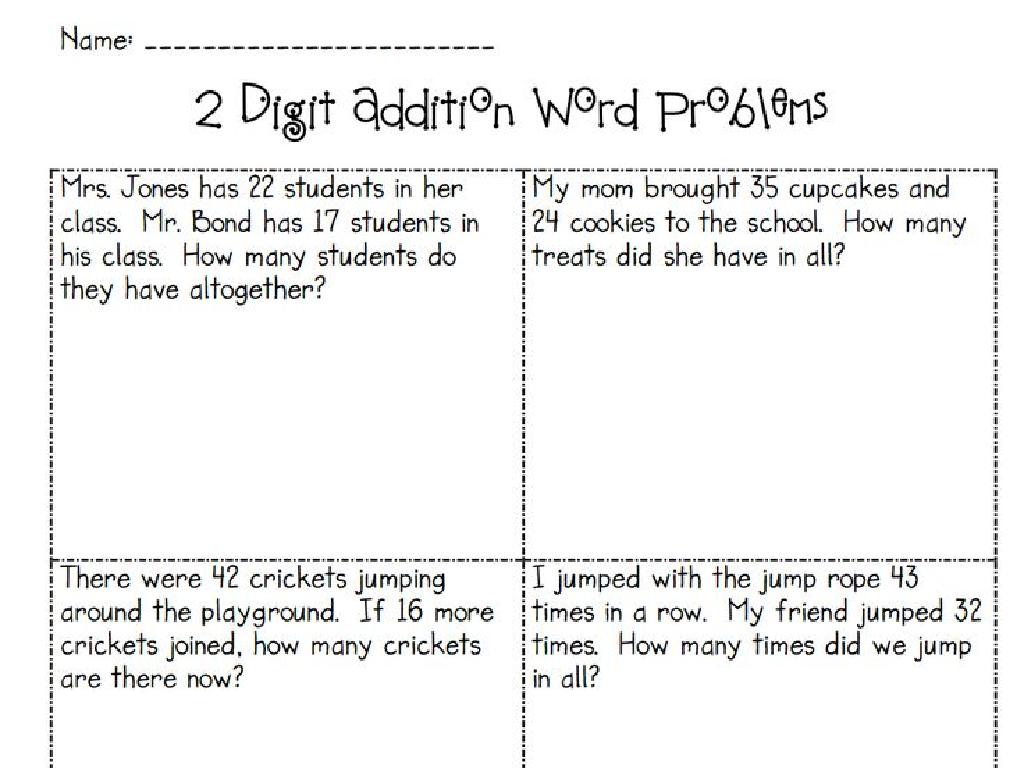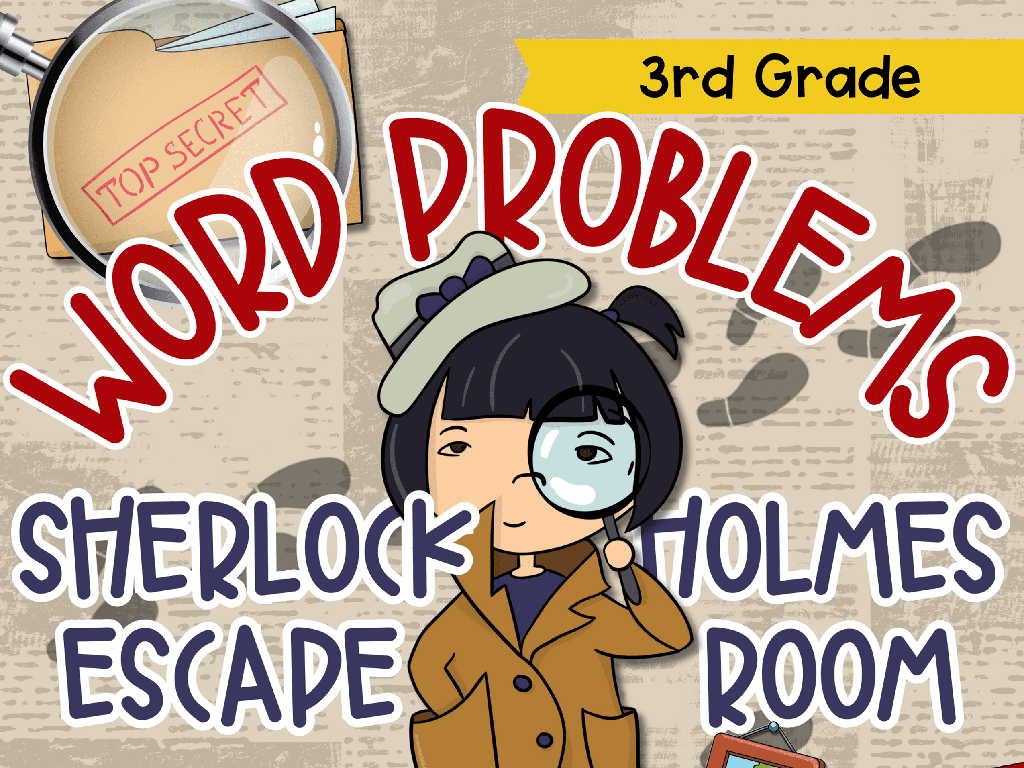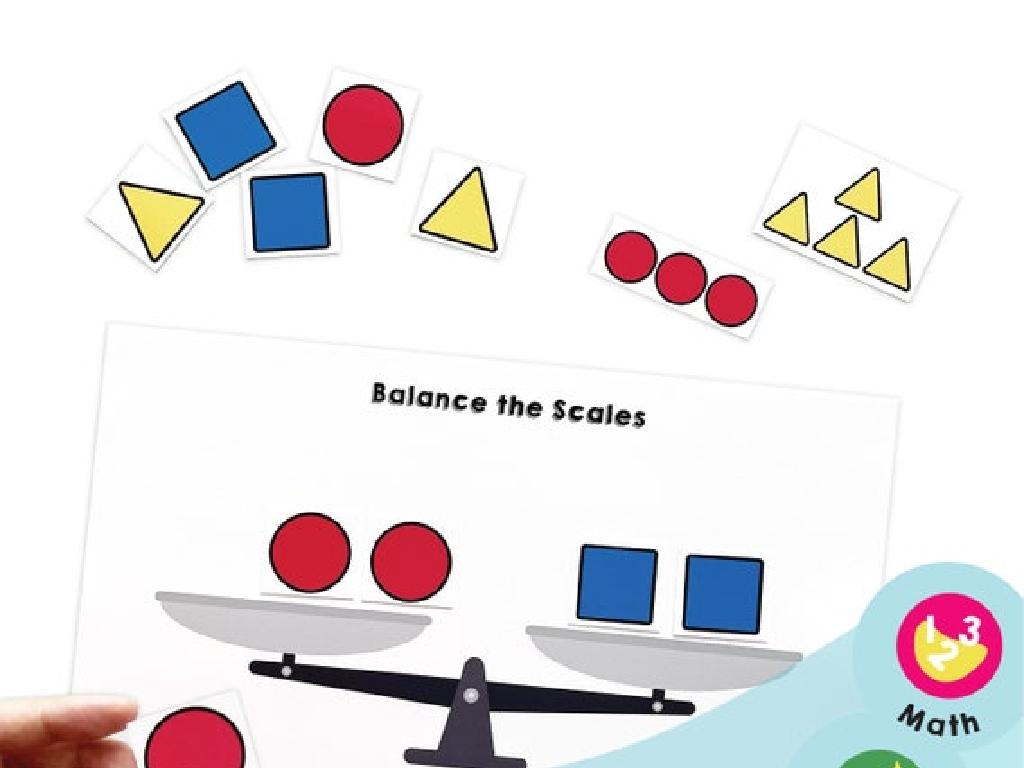Subtract Fractions With Like Denominators
Subject: Math
Grade: Fourth grade
Topic: Add And Subtract Fractions With Like Denominators
Please LOG IN to download the presentation. Access is available to registered users only.
View More Content
Introduction to Fractions
– Recap: What is a fraction?
– A fraction represents a part of a whole.
– Numerators vs. denominators
– Top number (numerator) and bottom number (denominator).
– Everyday life fraction examples
– Pizza slices, sharing candy, measuring cups.
– Practice with real objects
– Use items like fruit or toys to create fractions.
|
Begin the lesson by recapping the concept of a fraction as a part of a whole, which is crucial for understanding how to subtract fractions. Clarify the roles of numerators (the top number, indicating how many parts we have) and denominators (the bottom number, indicating into how many parts the whole is divided). Provide relatable examples such as slices of pizza or pieces of candy to illustrate fractions in a context familiar to fourth graders. Encourage hands-on practice by using real objects to create and visualize fractions, reinforcing the concept that fractions represent parts of a whole. This tactile experience will help solidify their understanding before moving on to subtraction of fractions.
Adding Fractions with Like Denominators
– Review adding same denominator fractions
– Recall: With same denominators, we combine only the top numbers
– Add numerators, keep denominators
– When adding 1/4 + 2/4, we add 1 + 2 to get 3/4
– Work through board examples
– I’ll demonstrate on the board, then you try
– Practice with class activity
– We’ll do a fun activity to practice adding fractions
|
Begin by reviewing the concept of adding fractions with like denominators, emphasizing that only the numerators (top numbers) are added while the denominator remains the same. Use visual aids on the board to demonstrate this concept with a few examples, such as 1/4 + 2/4 = 3/4, ensuring to walk through each step clearly. After the demonstration, engage the class with a hands-on activity where students can practice adding fractions with like denominators in pairs or small groups. Provide immediate feedback and support as needed. The activity can include fraction strips or visual pie charts to help students better understand the concept.
Subtracting Fractions with Like Denominators
– Subtract numerators directly
– If you have 3/4 – 1/4, just subtract 3 – 1 to get 2/4
– Denominator remains unchanged
– Visual example: pie charts
– Imagine taking a slice away from a pie
– Practice with simple fractions
– Try subtracting 2/6 – 1/6 on your own
|
Today’s lesson focuses on teaching students how to subtract fractions that have the same denominator. The key concept is that only the numerators change while the denominator stays the same. Use visual aids like pie charts or fraction bars to help students visualize what it means to subtract a part from a whole. Encourage students to think of the denominator as a ‘fixed container’ that doesn’t change when taking parts away. Provide several examples with visual representations and then let students practice with simple fractions to build confidence. Reinforce the idea that subtracting fractions is similar to subtracting whole numbers; they just need to remember to keep the denominator the same.
Subtracting Fractions with Like Denominators
– Ensure denominators match
– Denominators are the bottom numbers and they must be the same
– Subtract the numerators
– Take the top numbers and subtract them, like 3/4 – 1/4 = (3-1)/4
– Simplify the fraction
– If the number can be made smaller, do it! Like 2/4 becomes 1/2
|
This slide is aimed at teaching fourth graders how to subtract fractions when the denominators (the bottom part of the fractions) are the same. Start by checking that the denominators are identical. If they are, you can subtract the numerators (the top numbers). After subtracting, the fraction may need to be simplified, which means making it as small as possible. For example, 2/4 can be simplified to 1/2 because both 2 and 4 can be divided by 2. Use visual aids like fraction circles to help students understand the concept of ‘like denominators’ and the process of simplification. Encourage students to practice with different examples and provide immediate feedback to reinforce learning.
Fraction Subtraction Practice
– Solve problems as a group
– Let’s try subtracting fractions with the same bottom number together on the board.
– Work on problems individually
– Take a moment to solve these problems on your own paper.
– Discuss solutions together
– We’ll review the answers and methods as a class.
– Understand each step
– Make sure you know how to subtract the top numbers and keep the bottom number the same.
|
This slide is designed to engage students in active practice of subtracting fractions with like denominators. Begin by solving a few problems as a group to demonstrate the process. Then, allow students to work on a set of problems individually to apply what they’ve learned. Afterward, come together as a class to discuss the solutions, ensuring to highlight common mistakes and correct methods. Emphasize the importance of understanding each step in the process, not just getting the correct answer. Possible activities include peer teaching, using manipulatives for visual learners, and creating word problems that require fraction subtraction.
Subtracting Fractions in Real Life
– When do we use fraction subtraction?
– Example: Baking cookies
– If a recipe needs 3/4 cup sugar and you have 1 cup, how much is left?
– Group Activity: Measure ingredients
– Work in groups to measure out ingredients for a recipe using fractions.
– Calculate leftovers after baking
– Find out how much of each ingredient is left after making the recipe.
|
Understanding fractions is essential in everyday life, especially in activities like cooking or baking. For instance, when following a recipe, one might need to subtract the amount of an ingredient used from what is available to determine what remains. This slide introduces a practical application of subtracting fractions with like denominators through the context of baking. The group activity will involve students working together to measure ingredients according to a recipe, which will require them to subtract fractions. Teachers should prepare different recipes that require fraction subtraction for the activity and ensure that each group has a different recipe to work on. This will help students understand the concept of subtracting fractions and its usefulness in real-life situations.
Class Activity: Fraction Bingo
– Let’s play Fraction Bingo!
– Subtract fractions to advance
– Each correct answer marks a square
– Prizes for winners
– Rewards for Bingo achievers
– Fun for all participants
– Everyone gets recognition
|
This slide introduces a fun and interactive class activity called Fraction Bingo, designed to help fourth-grade students practice subtracting fractions with like denominators. Set up the classroom with Bingo cards where each square contains a different fraction subtraction problem. As students solve the problems, they mark off the corresponding squares on their Bingo cards. The first student to complete a row, column, or diagonal wins a prize. Ensure there are small rewards or recognition for all participants to encourage participation and celebrate their effort. Prepare several variations of Bingo cards to ensure a diverse range of problems. This activity will reinforce the concept of subtracting fractions in an engaging way and provide a hands-on learning experience.
Homework and Wrap-Up: Subtracting Fractions
– Complete the fraction worksheet
– Practice subtracting fractions with like denominators
– Simplify your answers
– Reduce fractions to simplest form
– Review your work for accuracy
– Double-check subtraction and simplification
– Bring any questions next class
|
For homework, students are tasked with completing a worksheet focused on subtracting fractions with like denominators. It’s crucial to emphasize the importance of simplifying their answers to the simplest form. Encourage students to review their work to ensure accuracy. Let them know that it’s okay to have questions and that they should bring any uncertainties to the next class for clarification. Provide guidance on how to simplify fractions and remind them of the strategies discussed in class for subtracting fractions effectively. This wrap-up activity will reinforce their understanding and provide an opportunity for practice.





